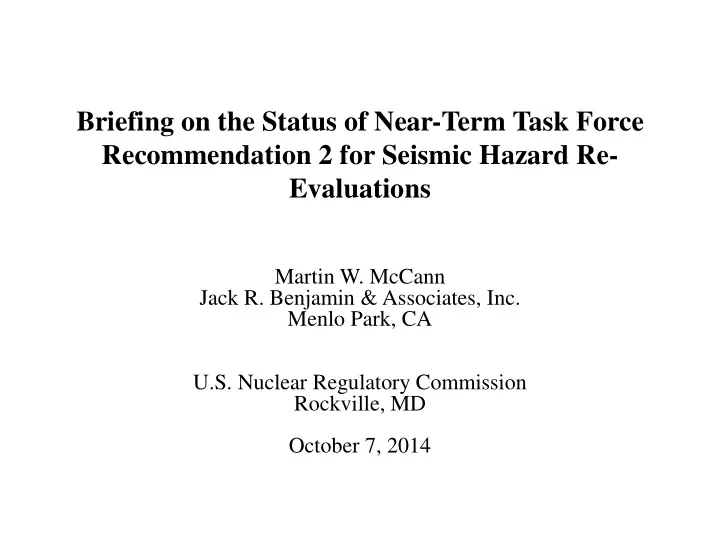

Briefing on the Status of Near-Term Task Force Recommendation 2 for Seismic Hazard Re- Evaluations Martin W. McCann Jack R. Benjamin & Associates, Inc. Menlo Park, CA U.S. Nuclear Regulatory Commission Rockville, MD October 7, 2014
Near-Term Task Force Recommendation 2 & Request for Information 50.54f Letter The Task Force recommends that the NRC require licensees to reevaluate and upgrade as necessary the design-basis seismic and flooding protection of SSCs for each operating reactor. Recommendation 2.1 - Seismic of the 50.54 (f) letter states what analyses utilities should perform as part of their response to the request for information with regard to the evaluation of seismic ground motion hazards at plant sites. 2
Commission Discussion Topic Lessons-learned from Fukushima and implementation of improvements related to seismic re-evaluations, in particular for U.S. nuclear power plants located in the western United States. 3
Probabilistic Seismic Hazard Analysis (PSHA) Elements of a PSHA / In 4 Parts Site Response Analysis Seismic Source Characterization Earthquake Earthquake Recurrence Locations Rock Ground Seismic Hazard Motion Curve (Modified from Reiter, 1990) 4
Implementation of the SSHAC Process • The standard for performing PSHAs is the SSHAC process (NUREG/CR-6372; NUREG-2117). • The SSHAC process is a structured, scientifically sound approach to identify, evaluate and integrate sources of epistemic (knowledge- based) uncertainty in problems that are seemingly unsolvable due to the nature of the uncertainties (their scale and complexity) and the need to utilize expert interpretations to evaluate them. • 50.54 (f) Letter – Recommendation 2.1 Seismic states that a SSHAC Level 3 analysis be performed to evaluate earthquake ground motion hazards at NPP sites. • This process has been applied to nuclear and non-nuclear applications (U.S., South Africa, Switzerland, British Columbia (dams), US. volcanic hazards, etc.). 5
Implementation Lessons • The SSHAC process: – Is a fundamentally sound approach to addressing with problems where expert evaluation and interpretation is (must be) used. – Evaluates & integrates (incorporates) the range and body of diverse, technically defensible interpretations into the assessment of future earthquake occurrences and ground motions. – Produces a product that supports regulatory review and stability. – Judged to provide technical stability for 10-15 years. – The participatory peer review is a valuable part of the SSHAC process; provides assurance that the ‘process’ is properly carried out by the project participants. 6
Implementation Lessons • The SSHAC process (cont.): – Uniquely suited to address new data and modeling issues: • British Columbia PSHA: – Use of geodetic data to estimate earthquake recurrence – Improved seismic source modeling approach that utilizes available geologic evidence (zone-embedded fault seismic source characterization) • Diablo Canyon & Palo Verdi PSHAs – Improved ground motion modeling • DOE & Energy Northwest – Earthquake catalog and uncertainty analysis • Addresses directly, in a scientific environment, topics that are often complex and as the case might be controversial topics. 7
Site Response • The ‘final’ part of the seismic ground motion hazard takes into account the near-surface geology; translates rock motion through near-surface soil layers to plant structures. • Soil effects can significantly influence the ground motions that a plant may experience. PSHA Site Evaluated in the context of the Response SSHAC process Analysis 1 Rock Spectral Acceleration (g) Surface-Soil 0.1 0.01 0.1 1 10 100 Frequency (Hz.) 8 (Munson, 2014)
Site Response (cont.) • Site response analysis is not evaluated in the context of the SSHAC process; does not have the same level of peer review for instance. • Issues: – Availability of up-to-date site data (on near-surface geology; shear- wave velocity measurements, etc.) – Evaluation of sources of aleatory (randomness) and epistemic (knowledge-based) uncertainty – Evaluation of modeling uncertainty in site-response analysis – Peer review 9
Further Lessons • The NRC strategy for addressing seismic hazard issues, is a positive and forward thinking approach to addressing complex scientific issues that are important to plant safety and public confidence. – Original support for the develop of the SSHAC process and subsequent endorsement of it (NUREG 2117). – Regional-scale collaboration with industry, the USGS, Department of Energy to develop the CEUS seismic source characterization model. – Site-specific requirement that re-evaluation of seismic hazards at western plants carry out a SSHAC Level 3 analysis. 10
Further Lessons • This is a successful ‘template’ that: – Brings a high-level of technical quality to the evaluation of natural hazards. – A level of regulatory stability that is a plus for the regulator and utilities (a positive that was not common in the ‘early days’ of siting of nuclear power plants; where data is limited and interpretations by experts must be relied). – Applicable to other external hazards addressed in the 50.54f letter such as hydrologic events, storm surge, and floods initiated by seismic events (e.g., dam failures). 11
Acronyms NPP – Nuclear power plant PSHA – Probabilistic Seismic Hazard Analysis SSHAC – Senior Seismic Hazard Analysis Committee SSHAC Process – The process of evaluation and integration of SSHAC Level 3 – A level of analysis recommended by SSHAC that is required for the evaluation of seismic hazards by the NRC request for information (50.54 (f) letter). 12
Recommend
More recommend